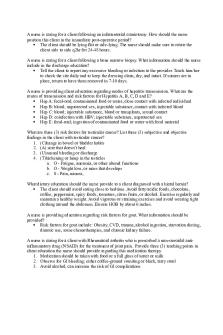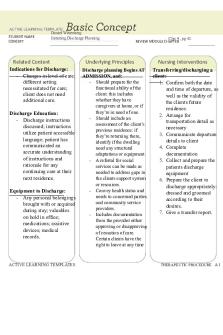Med-Surg Capstone remediation PDF

| Title | Med-Surg Capstone remediation |
|---|---|
| Author | Anji Ariel |
| Course | Medical Surgical Nursing I |
| Institution | Medical University of South Carolina |
| Pages | 4 |
| File Size | 78.9 KB |
| File Type | |
| Total Downloads | 20 |
| Total Views | 143 |
Summary
med surge capstone remediation...
Description
A nurse is caring for a client following an infratentorial craniotomy. How should the nurse position this client in the immediate post-operative period? The client should be lying flat or side-lying. The nurse should make sure to rotate the client side to side q2hr for 24-48 hours. A nurse is caring for a client following a bone marrow biopsy. What information should the nurse include in the discharge education? Tell the client to report any excessive bleeding or infection to the provider. Teach him/her to check the site daily and to keep the dressing clean, dry, and intact. If sutures are in place, return to have them removed in 7-10 days. A nurse is providing client education regarding modes of hepatitis transmission. What are the routes of transmission and risk factors for Hepatitis A, B, C, D and E? Hep A: fecal-oral; contaminated food or water, close contact with infected individual Hep B: blood; unprotected sex, injectable substance, contact with infected blood Hep C: blood; injectable substance, blood or transplants, sexual contact Hep D: coinfection with HBV; injectable substance, unprotected sex Hep E: fecal-oral; ingestion of contaminated food or water with fecal material What are three (3) risk factors for testicular cancer? List three (3) subjective and objective findings in the client with testicular cancer? 1. (C)hange in bowel or bladder habits 2. (A) sore that doesn’t heal 3. (U)nusual bleeding or discharge 4. (T)hickening or lump in the testicles a. O - Fatigue, anorexia, or other altered functions b. O - Weight loss, or mass that develops c. S - Pain, nausea, What dietary education should the nurse provide to a client diagnosed with a hiatal hernia? The client should avoid eating close to bedtime. Avoid fatty/acidic foods, chocolate, coffee, peppermint, spicy foods, tomatoes, citrus fruits, or alcohol. Exercise regularly and maintain a healthy weight. Avoid vigorous or straining exercises and avoid wearing tight clothing around the abdomen. Elevate HOB by about 6 inches. A nurse is providing education regarding risk factors for gout. What information should be provided? Risk factors for gout include: Obesity, CVD, trauma, alcohol ingestion, starvation dieting, diuretic use, some chemotherapies, and chronic kidney failure. A nurse is caring for a client with Rheumatoid arthritis who is prescribed a non-steroidal antiinflammatory drug (NSAID) for the treatment of joint pain. Provide three (3) teaching points in client education the nurse should provide regarding this medication therapy. 1. Medication should be taken with food or a full glass of water or milk 2. Observe for GI bleeding; either coffee-ground vomiting or black, tarry stool 3. Avoid alcohol; can increase the risk of GI complications
A nurse is caring for a client experiencing metabolic acidosis. What are three (3) causes of metabolic acidosis? 1. Excessive diarrhea 2. Hypoxia 3. Starvation A nurse is caring for a client with pneumonia. What are three (3) physical assessment findings that are noted with the development of pneumonia? 1. Crackles and wheezing 2. Yellow-tinged sputum production 3. Flushed face, fever and chills with pleuritic pain A client diagnosed with asthma recently had pulmonary function testing. The client asks the nurse ‘What is peak expiratory flow?’ What information should the nurse provide? It measures the volume of air from inhalation to exhalation. Peak expiratory flow gives the rate of the fastest air flow during exhalation. 15-20% lower than the average person is the expected PEF for clients with asthma. After taking a bronchodilator the percentage should give an extra 12%. This also determines the severity of a client’s asthma at a given time. The client should perform PEF at least 3 times and take the best result, compare to their asthma action plan and continue with the following interventions provided for the result. A nurse is evaluating the client's understanding of post cataract surgery instructions. The client needs further education when they state. "I will report any yellow drainage to my provider". "I can return to my normal activities like cleaning my house and vacuuming." "I will report any nausea or vomiting". "My vision will improve over the next 4 to 6 weeks". A nurse is providing pre-procedural instructions to the client having a barium swallow. What instructions should be included in this teaching? Select all that apply. 1. NPO after midnight 2. No smoking after midnight 3. Stools will be white for 24 to 72 hours post procedure 4. The feeling of abdominal fullness is normal post procedure 5. Client can have a regular diet before the procedure What are the expected assessment findings for a herniated lumbar disk? Lower back pain with a burning or stabbing pain to one foot or leg; sciatic nerve involvement and compression. Pain increase with straining. Chills/fever or bowel incontinence or inability to move can indicate further involvement and complications.
A nurse is caring for a client with multiple risk factors for peripheral vascular disease. List four (4) risk factors associated with peripheral vascular disease. 1. Hypertension 2. Diabetes Mellitus 3. Cigarette smoking 4. Obesity/ hyperlipidemia A nurse is caring for a client following a hypophysectomy. What postoperative nursing actions should be taken for this client? Monitor sodium, potassium, and chloride; glucose levels; ECG Infection precautions Monitor for bleeding or CSF leakage Assess neuro-status q1hr for first 24hr Administer glucocorticoid to prevent drop in cortisol Administer stool softener to prevent straining What type of respiratory failure is caused by Guillain-Barre’ syndrome? Ventilatory respiratory failure A client is diagnosed with Addisonian Crisis. List the lab values that will be affected by this disease process. Increase potassium Increased calcium Decreased sodium Increased BUN and creatinine Decreased serum cortisol Normal or decreased glucose A nurse is caring for a client with a history of migraines with auras. What are the stages of this type of migraine? 1. Prodromal stage – awareness of s/s for hours: irritable, depressed, food cravings, diarrhea/constipation; Aura starts including numbness or tingling, visual disturbances, and acute confusion. 2. Second stage – severe, incapacitating, and throbbing headache; N/V, vertigo, and drowsiness 3. Third stage – Pain subsides, headache is dull, aura starts to diminish Fill in the Blank: Multiple sclerosis can cause vision changes including _diplopia___________, ____nystagmus___________________, and ____decrease visual acuity_____. A nurse is providing education to a client with polycystic kidney disease (PKD). What are the four (4) disease management areas to review with this client? 1. Nutrition – strict i/o and fluid restriction along with sodium and potassium restriction
2. Cardiovascular – changes in ECG and dysrhythmias 3. Respiratory – crackles, pulmonary edema, or changes in ABG’s 4. Renal – daily weights, changes in urinary elimination, bloody urine...
Similar Free PDFs

Med-Surg Capstone remediation
- 4 Pages

Medsurg 222
- 8 Pages

Nurseslabs-medsurg
- 9 Pages

Nursing Concept Map Medsurg 2
- 2 Pages

Remediation (Hypocalcemia)
- 1 Pages

Chapter 25 Medsurg
- 14 Pages

Remediation riassunto
- 13 Pages

Fundamentals capstone
- 5 Pages

Capstone Template
- 19 Pages

Remediation Nutrition
- 6 Pages

Capstone Template
- 20 Pages

NUR 232 ATI Remediation
- 7 Pages

Discharge Planning Remediation
- 1 Pages
Popular Institutions
- Tinajero National High School - Annex
- Politeknik Caltex Riau
- Yokohama City University
- SGT University
- University of Al-Qadisiyah
- Divine Word College of Vigan
- Techniek College Rotterdam
- Universidade de Santiago
- Universiti Teknologi MARA Cawangan Johor Kampus Pasir Gudang
- Poltekkes Kemenkes Yogyakarta
- Baguio City National High School
- Colegio san marcos
- preparatoria uno
- Centro de Bachillerato Tecnológico Industrial y de Servicios No. 107
- Dalian Maritime University
- Quang Trung Secondary School
- Colegio Tecnológico en Informática
- Corporación Regional de Educación Superior
- Grupo CEDVA
- Dar Al Uloom University
- Centro de Estudios Preuniversitarios de la Universidad Nacional de Ingeniería
- 上智大学
- Aakash International School, Nuna Majara
- San Felipe Neri Catholic School
- Kang Chiao International School - New Taipei City
- Misamis Occidental National High School
- Institución Educativa Escuela Normal Juan Ladrilleros
- Kolehiyo ng Pantukan
- Batanes State College
- Instituto Continental
- Sekolah Menengah Kejuruan Kesehatan Kaltara (Tarakan)
- Colegio de La Inmaculada Concepcion - Cebu


